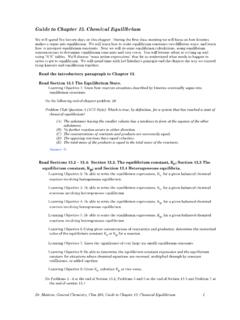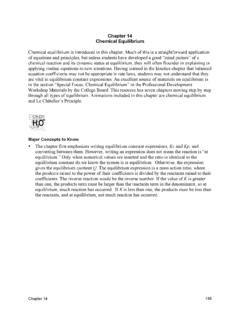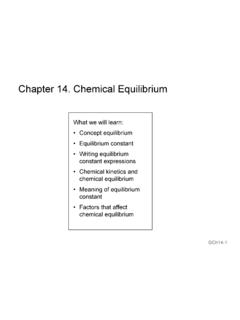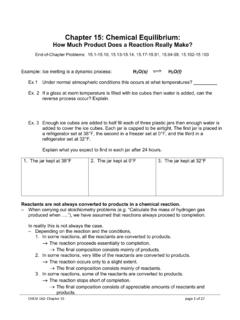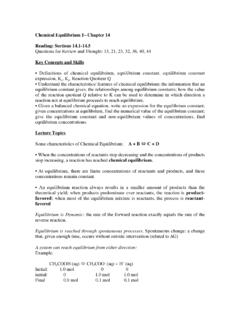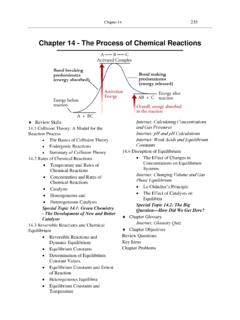Transcription of CHAPTER 14 (MOORE) CHEMICAL EQUILIBRIUM
1 CHAPTER 14 (MOORE) CHEMICAL EQUILIBRIUM This CHAPTER deals with CHEMICAL EQUILIBRIUM , or how far CHEMICAL reactions proceed. Some reactions convert reactants to products with near 100% efficiency but others do not. CHEMICAL EQUILIBRIUM is a dynamic process, and occurs when the rates of two opposing processes (reactions) become the same. Unless conditions are somehow changed, the concentrations of both reactants and products remain constant after EQUILIBRIUM is achieved. Consider the decomposition reaction in which N2O4 (g) ' 2 NO2(g) What happens to the concentration of each, based upon the rate equations, as the reaction proceeds? Assuming reversible elementary processes, Rate (forward) = k (forward) x [N2O4] and rate (reverse) = k (reverse) x [NO2]2 As [N2O4] decreases, rate forward decreases, and, as [NO2] increases, rate reverse increases, but more quickly.
2 Why? Let s look at the graph of concentration vs. time ..the concentration lines converge at EQUILIBRIUM . We can also graph changes in concentrations with time for 2 HI(g) ' H2(g) + I2(g) (see also Fig. , Moore, p. 676) Is there a mathematical relationship between [HI], [H2] and [I2]? Expressing EQUILIBRIUM Relationships 2 HI(g) ' H2(g) + I2(g), where rate(forward) = kf[HI]2 and rate(reverse) = kr[H2][I2] or, rate(forward) = rate(reverse) D kf[HI]2 = kr[H2][I2] and, (kf/kr) = [H2][I2]/[HI]2 = constant = KC (the EQUILIBRIUM constant) KC is called the concentration-based EQUILIBRIUM constant! The product concentrations are on top and the reactant concentrations are on the bottom. Regardless of the starting concentrations, the value of the expression, with product concentrations in the numerator, and reactant concentrations in the denominator, where each concentration is raised to the power of its coefficient in the balanced CHEMICAL equation, is equal to a constant.
3 The EQUILIBRIUM Constant Expression (sometimes called the mass action expression) For the general reaction: aA + bB gG + hH, the EQUILIBRIUM expression is: Kc = {[G]g[H]h} / {[A]a[B]b} Products Reactants The EQUILIBRIUM Constant The EQUILIBRIUM constant is constant regardless of the initial concentrations of reactants and products, as long as the temperature remains constant. The concentration EQUILIBRIUM constant is KC Concentrations of the products appear in the numerator and concentrations of the reactants appear in the denominator. Recall that [A] means molar concentration of A. Important: the exponents of the concentrations are identical to the stoichiometric coefficients in the CHEMICAL equation!!
4 Example If the EQUILIBRIUM concentrations of COCl2 and Cl2 are the same at 395 C, find the EQUILIBRIUM concentration of CO in the reaction: CO(g) + Cl2(g) ' COCl2(g) KC = x 103 at 395 C First, write the KC expression, where KC = x 103 = [COCl2] / [CO][Cl2] Then, {COCl2] = [Cl2], so substitute in the EQUILIBRIUM expression, and KC = x 103 = [Cl2] / [CO][Cl2] = 1/[CO] @ [CO] = x 10-4 M Reversing the Direction of the CHEMICAL Equation How does this affect the form of KC? Consider the reaction: 2 NO(g) + O2(g) ' 2 NO2(g) Then, KC = [NO2]2 / [NO]2 [O2] Now consider 2 NO2(g) ' 2 NO(g) + O2(g), where KC = [NO]2[O2] / [NO2]2 You should see that KC = 1/KC When the reaction direction is reversed, KC = 1/KC Modifying the CHEMICAL Equation: Changing Coefficients Changing the coefficients in a balanced equation affects the form of the EQUILIBRIUM expression!}
5 Example The EQUILIBRIUM constant at 718 K for the reaction below is H2(g) + I2(g) ' HI(g) (a) What is the value of KC at 718 K for the reaction, HI(g) ' H2(g) + I2(g) Solution. Reversing the reaction means taking the reciprocal of KC: K C = 1 = (b) What is the value of KC at 718 K for the reaction, H2(g) + I2(g) ' 2 HI(g) Solution. Doubling the coefficients in the original balanced equation means squaring KC: K C = ( )2 = Modifying the CHEMICAL Equation: Changing Coefficients Another example .. If KC = x 10-20 for N2(g) + 3/2 H2O(g) ' NH3(g) + O2(g) at 900 K, what is KC at the same temperature for the reaction 4 NH3(g) + 3 O2(g) ' 2 N2(g) + 6 H2O(g)? Solution. Reversing the reaction and quadrupling the coefficients means raising all exponents by a factor of 4 and taking the reciprocal of KC: K C = 1/( x 10-20)4 = x 1078 EQUILIBRIUM Constants for Overall Reactions When reactions occur in two or more steps, we can use the KC values for each step to calculate KC for the overall process.
6 Suppose we need: N2O(g) + 3/2 O2(g) ' 2 NO2(g) KC(1) = ?? and we re given: N2O(g) + O2(g) ' 2 NO(g) KC(2) = x 10 132 NO(g) + O2(g) ' 2 NO2(g) KC(3) = x 1013 Adding the given equations gives the desired equation. Multiplying the given values of K gives the EQUILIBRIUM constant for the overall reaction. Adding equations 2 and 3 gives: N2O(g) + 3/2 O2(g) ' 2 NO2(g) Multiplying KC(2) by KC(3), we get KC(1) = ( x 10 13)( x 1013) = Equilibria Involving Gases - In reactions involving gases, we often use partial pressures in place of molarities. This means that we have to use a partial pressure EQUILIBRIUM constant. For the reaction, aA(g) + bB(g) ' gG(g) + hH(g), KP = {(PG)g (PH)h} / {(PA)a (PB)b} where the P values represent partial pressures, typically in atm or mmHg KC and KP are related by: KP = KC (RT) n(gas)where n(gas) is the change in the total number of moles of gas as the reaction occurs in the forward direction.
7 More specifically, n(gas) = mol gaseous products mol gaseous reactants Example Consider the EQUILIBRIUM between dinitrogen tetroxide and nitrogen dioxide: N2O4(g) ' 2 NO2(g) Kp = at 319 K (a) What is the value of Kc for this reaction? (b) What is the value of Kp for the reaction 2 NO2(g ' N2O4(g)? (c) If the EQUILIBRIUM partial pressure of NO2(g) is atm, what is the EQUILIBRIUM partial pressure of N2O4(g)? Solution. N2O4(g) ' 2 NO2(g) Kp = atm at 319 K (a) What is the value of Kc for this reaction? Kp = KC (RT) n(gas) where R = L atm mol-1 K-1 Here, n(gas) = 2 1 = +1 KC = atm/{( L atm mol-1 K-1)(319 K)}+1 = mol L-1 (b) What is the value of Kp for the reaction , 2 NO2(g) ' N2O4(g)?)
8 Now, the reaction direction is reversed ..recall that KP = 1 / KPSo, KP = 1/( atm) = atm-1 (c) If the EQUILIBRIUM partial pressure of NO2(g) is atm, what is the EQUILIBRIUM partial pressure of N2O4(g)? Begin by writing the KP EQUILIBRIUM expression .. Kp = (pNO2)2 / (pN2O4)1 = atm and, then, substitute for p(NO2) = atm Kp = ( atm)2 / (pN2O4)1 = atm p(N2O4) = ( atm)2 / ( atm) = atm Equilibria Involving Pure Solids and Liquids The EQUILIBRIUM constant expression does not include terms for pure solid and liquid phases because their concentrations do not change in a reaction. Although the amounts of pure solid and liquid phases change during a reaction, these phases remain pure and their concentrations do not change.
9 Example: CaCO3(s) ' CaO(s) + CO2(g) KC = ??? KC = [CO2]1 Example (see also Moore, Problem,-Solving Example (b), p. 678) The reaction of steam and coke (a form of carbon) produces a mixture of carbon monoxide and hydrogen, called water-gas. This reaction has long been used to make combustible gases from coal: C(s) + H2O(g) ' CO(g) + H2(g) Write the EQUILIBRIUM constant expression for KC for this reaction. KC = {[CO][H2]} / [H2O] Why no [C]? Because C is a pure solid, C(s)! EQUILIBRIUM Constants: When Do We Need Them? A very large numerical value of Kc or Kp signifies that a reaction goes (essentially) to completion. A very small numerical value of Kc or Kp signifies that the forward reaction, as written, occurs only to a slight extent.
10 An EQUILIBRIUM constant expression applies only to a reversible reaction at EQUILIBRIUM . Although a reaction may be thermodynamically favored, it may be kinetically controlled .. Thermodynamics tells us it s possible (or not) . Kinetics tells us if it s practical (or not) Example Is the reaction CaO(s) + CO2(g) ' CaCO3(s) likely to occur to any appreciable extent at 298 K? We know that for CaCO3(s) ' CaO(s) + CO2(g) KP = x 10-23 What does this tell us? That this reaction is reactant favored or that the EQUILIBRIUM lies to the left. Lots of CaCO3 with very little CO2 .. where KP = p(CO2)1. Therefore, this reaction favors the formation of CaCO3, so the answer is YES! The Reaction Quotient, Q For nonequilibrium conditions, the expression having the same form as Kc or Kp is called the reaction quotient, Qc or Qp.

